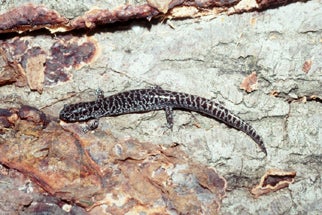SCIENTIFIC NAME:
Ambystoma bishopi (Cope)
OTHER NAMES:
None.
STATUS:
Endangered. Formerly Ambystoma cingulatum before split into eastern frosted frosted flatwood salamander (A. cingulatum) and western A. bishopi. Historically known from five states in low pine flatwoods of Southern Coastal Plain, Dougherty Plain, and Southern Pine Plains and Hills. Not documented in Alabama in more than two decades despite surveys from 1992 to 1995. May persist in scattered remnants of intact habitat, which continue to decline through fire suppression, development, and conversion of forest type. HIGHEST CONSERVATION CONCERN.
DESCRIPTION:
A medium-sized (up to about 12 cm [5 in.] long) salamander, with a relatively small head and long, fat tail. Adults blackish with fine light gray or white lines on the back and sides, forming a reticulum or netlike pattern; lines often fainter on top of the back. Belly with small, light specks. Small grooves below nostril on upper lip absent. Larvae brown and broad-headed with bushy external gills; white belly; sides of the body with a single, narrow yellow or white longitudinal stripe. Light brown face has a thin dark brown stripe passing through eye from nostril to external gills. No other broad-headed salamander larva has conspicuous lateral stripes.
DISTRIBUTION:
Restricted to the southeastern United States. Coastal Plain, from southern half of South Carolina southward to Marion County in north-central Florida, and westward at least to Mobile County, Alabama. In Alabama, distribution confined to southernmost tier of counties (Mobile, Baldwin, Escambia, Covington, Geneva, and Houston) in the Lower Coastal Plain, although most recent records only from Covington and Houston Counties (1980 and 1981, respectively) (Mount 1980a, Godwin 1994).
HABITAT:
Pine flatwoods. Larvae found in shallow pondcypress or blackgum ponds, marshy pasture ponds, roadside ditches, or small, shallow borrow pits (Palis and Means 2003). Adults live underground in the longleaf pine flatwoods surrounding breeding sites and may be dependent upon some microhabitat aspect of the wiregrass dominated groundcover for long-term survival (Means et al. 1996).
LIFE HISTORY AND ECOLOGY:
Secretive. One of only two members of family that breed in fall. Adults migrate to breeding sites during rainy weather in October and November, before ponds fill with water, where they court (Anderson and Williamson 1976). Females lay groups of one to 35 eggs (for a total of up to at least 225) at the bases of bushes, small trees, and clumps of grass, usually in lowest parts of depressions in shallow water or in wet vegetation on land. Eggs laid on land in lowest parts of depressions begin developing immediately, but larvae remain within the eggs until heavy rains fill the depressions. Hatching usually occurs in Decem-ber or January. Larvae live an aquatic life for about three months in shallow ponds without fish, and usually are associated with emergent grasses and sedges. Metamorphosis occurs in March and April (Palis 1995). Post-larval life unknown, but some evidence that metamorphosed individuals can disperse up to 1.7 kilometers (approximately one mile) from breeding ponds (Ashton 1992). Captive-raised metamorphs reached adult size in one year, but growth rates in the field unknown. Age at maturity, longevity, survivorship, and limiting factors are important aspects little studied.
BASIS FOR STATUS CLASSIFICATION:
Entire distribution small and no individuals found in Alabama since 1981 despite intensive survey of 143 ponds in winter (1992-93, 1993-94) (Godwin 1994). Pine flatwoods-wiregrass habitat diminishing rapidly due to agriculture, site preparation tree farming, and urban and suburban development (Means et al. 1996, Palis 1996). Species unable to survive in human-made habitats, so prospects for long-term survival directly related to the rate of disappearance of native longleaf pine flatwoods habitat.
Author: D. Bruce Means






